#pesto verde
Explore tagged Tumblr posts
Text
Receta de Judías verdes, espárragos y guisantes con pesto verde
Receta de Judias verdes, esparragos y guisantes con pesto verde Publicado por Escuela de Cocina y Pasteleria Terra de Escudella el 18 de junio de 2024 Requiere 30 min, para cuatro personas. Ingredientes · 100 gr de guisantes · manojo de espárragos verdes · 200 gr de judías verdes Para el Pesto verde · 20 gr de albahaca · 20 gr de perejil · 15 gr de piñones · 20 gr de queso parmesano · 2 yemas…

View On WordPress
0 notes
Text
Hey guys random but I wanna share this spinach pasta recipe I improvised the other day bc it's really east and tasty and a nice way to eat my greens... I've eaten it for the last several meals lol
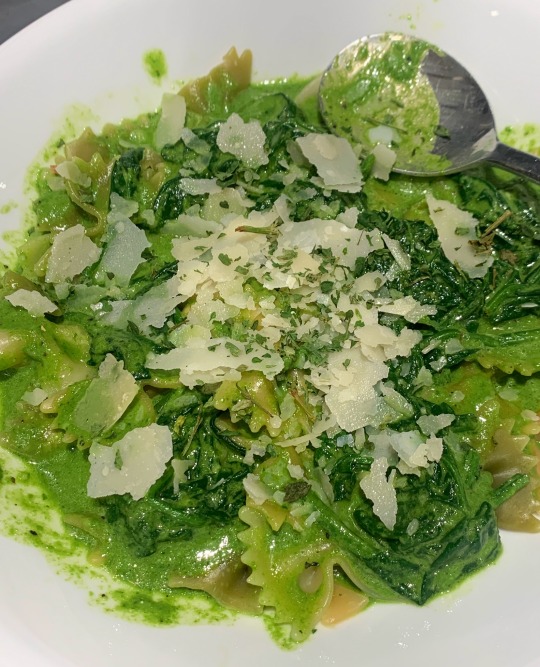
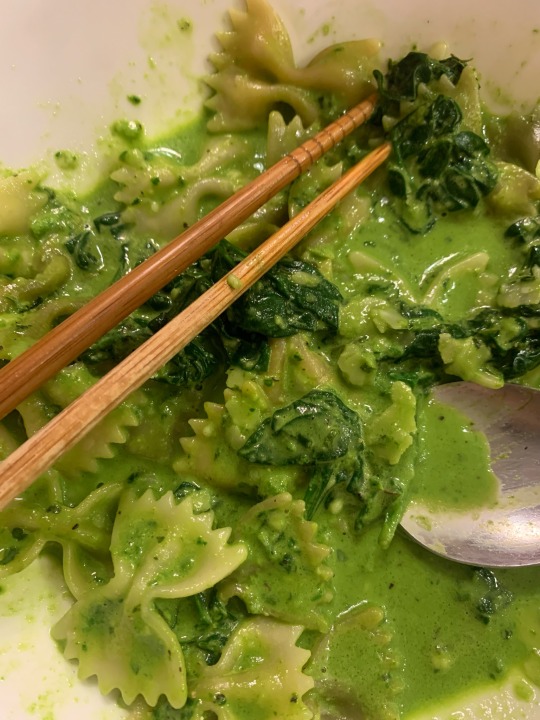
sauce recipe (1 serving)
fresh spinach several(3?) handfuls (blended with sauce)
oat milk ~1/3 c (or a diff unsweetened milk)
small pat of butter(flavor) + 3 spoonfuls olive oil
lots of black pepper + couple shakes garlic powder (or minced garlic)
tiny pat of miso/deonjang (if u dont have it, just add more cheese, or some salt to taste)
Lots of pecorino romano or parmesan cheese (or both)
+
more handfuls spinach to eat w pasta whole, opt (several/3 handfuls; keep in mind spinach shrinks a lot when cooked) (cooked in microwave, with sauce liquid)
more cheese, black pepper, parsley etc for serving
Note: need a blender to make the spinach sauce green. I used a small bullet blender. If you don't have a blender, just cook and eat the spinach pieces whole alongside the pasta instead of blending it w the sauce, like an alfredo cream sauce.
With whole spinach pieces:
>combine sauce ingred in tall, microwave safe bowl except spinach & cheese; microwave 30 sec to melt butter/miso and mix thoroughly
>add several handfuls of spinach to the sauce liquid; this is the whole spinach pieces.
>cover + microwave for 1 min /until the spinach leaves are completely wilted and tender but still green
if u dont have a blender you'd be done here (microwave longer to reduce, add more cheese/oil to make it thicker, etc)
>add 2-3 handfuls fresh spinach into bullet blender and pour in most of the sauce liquid; Blend until fully broken down into a creamy green sauce. (add a splash more milk if it's not blending)
>combine w rest of sauce in the bowl; add cheese and microwave 30+ sec more uncovered (*i add cheese at the end bc it's harder to blend with the spinach)
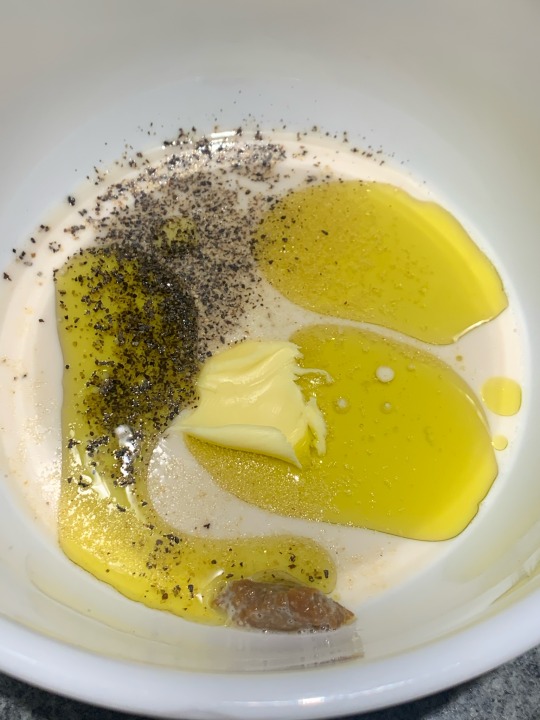
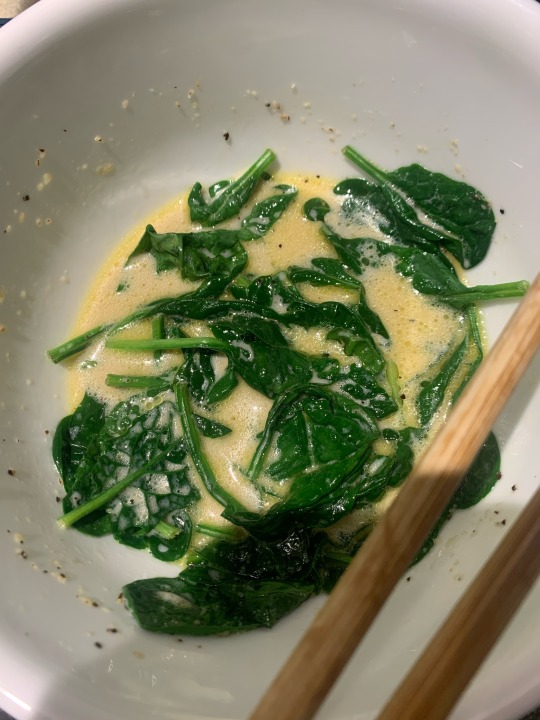
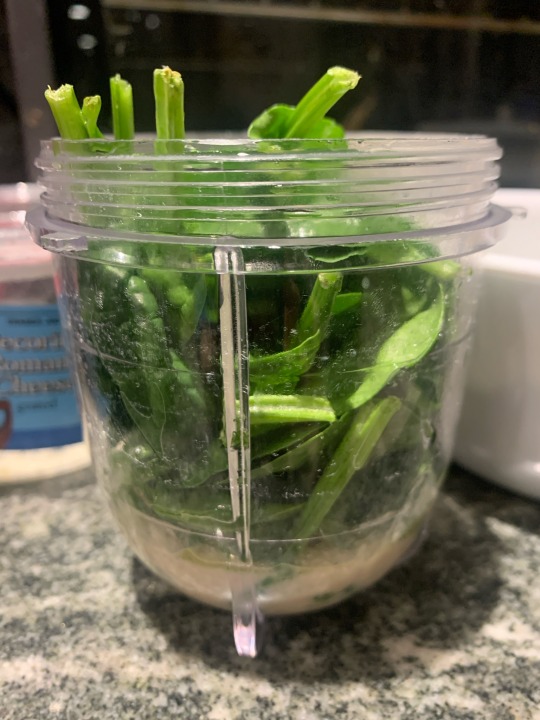
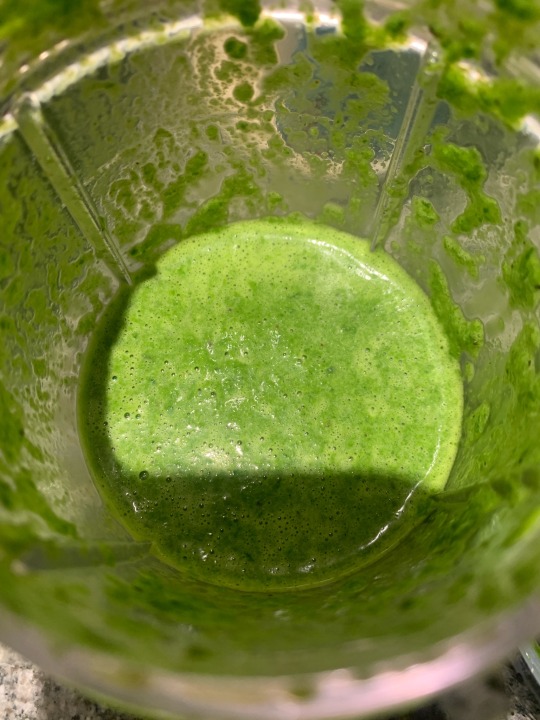

Without whole spinach pieces (just green sauce): combine all sauce ingred Including spinach into bullet blender; blend until fully combined; transfer to bowl & microwave 1 min + longer as needed to reduce (uncovered)
Pasta:
> boil pasta in salted water according to directions (go a min under and test if its cooked, for al dente pasta)
> drain + return to pot, add the sauce + stir
note: if doing this method u can also make the sauce in the same pot instead of using a microwave; after draining the pasta, leave it in strainer, and make the sauce in the same pot and simmer... turn up the heat to boil + reduce as desired, then add the pasta back in and stir until hot. (If i was making a bigger portion for multiple ppl i'd prob do this)
USING LEFTOVER COOKED PASTA (this is what i did, bc i had made a lot of pasta a few days ago, and had the leftovers stored in fridge):
> microwave pasta by itself in a bowl/plate for 1 min, covered
> add the hot sauce on top of hot pasta (microwave first if it's not hot enough)
(^i microwave sauce + pasta separately to ensure the pasta stays al dente btw... if u microwave sauce with pasta it gets soft)
(If making large batches ahead I'd store the pasta and sauce separately for the same reason... I'd prob do the same thing I did, make a large batch of pasta and then make the sauce right before eating... I just hate soft pasta tho so if u dont then dw abt it🫡 lol)
> Top w extra cheese, black pepper, parsley and serve/eat immediately!!

#food#pasta#spinach#spinach pasta#recipe#my recipe#cooking#easy meals#its rly easy and tasty... and its easier to eat spinach this way lmao#if u dont want to eat the whole spinach pieces blend all the spinach w the sauce#its rly delicious... ive eaten this for the past 3 meals to use up my leftover pasta#and its so good...#if u added basil leaves too thatd basically be pesto...#i dont have basil rn tho#i like this bc it reminds me of that peruvian dish that i rly like... what was it called?#green noodles...#*googles* tallarines verdes... i should try actually making that sometime its prob not much harder#but for now i rly like this recipe and wanted to share... success...
363 notes
·
View notes
Text










Some of my favorite meals I’ve made this summer, most with either food from my garden or foraged!
Here’s what everything is:
Mushroom “pot roast”, chile verde rice bowl, squash blossom quesadillas, breakfast tacos, wild green pesto pasta with stuffed and fried squash blossoms, honey baked filo wrapped feta with garden salad, our birthday party feast (lots of fruit, big salad, garden focaccia not pictured, a birthday cake made with himalayan balsam blossom raspberry jam not pictured, and blackberry rolls), roasted veg mix with Bärlauchbutter, falafel with rice and cucumber salad, and my latest creation which is squash blossom mac and cheese with crispy garlic green beans. I’ll probably do another post with things that didn’t fit in this one!
Oh, this has been so fun! I’m now ready for many stews and soups and chestnuts and wild mushrooms, please 🌰🍄🟫🍄
105 notes
·
View notes
Text

Ecco i motivi per cui è bello essere Liguri: ❤
1. Avere mare e monti a distanza di 30 minuti, forse anche meno.
2. Non conoscere il concetto di nebbia.
3. La “focaccia” calda a tutte le ore.
4. La cucina ligure , che riesce ad essere ricca con quasi niente.
5. “Belìn”, questo nostro intercalare onesto, melodioso e mai volgare.
6. Le fessure blu cobalto del cielo tra le case dei “caruggi”. (I vicoli).
7. La colazione “alla ligure” con la “fugassa” (Focaccia) pucciata nel caffelatte.
8. Gli autobus che si inerpicano anche sulle strade più assurde.
9. Un gatto che scruta il mondo dalla fessura di una persiana verde.
10. Poter fare il bagno in mare ad ottobre come se fosse la cosa più normale del mondo.
11. Il “pesto”, che ci offendiamo se gli altri lo copiano, anche se sappiamo benissimo che oramai lo fanno cani e porci.
12. Salire in 10 minuti per "bricchi” (Montagne attorno alle nostre città ) e trovarsi fuori dal mondo.
13. Salire in 10 minuti per “bricchi” e trovarsi dentro una calda osteria.
14. I veri liguri....Quelli che “una parola è poco, ma due sono già troppe!"
15. I veri liguri , così “chiusi” e così grandi di cuore.
16. Sentire i nostri vecchi parlare in dialetto e riuscire a capire quello che dicono (più o meno).
17. Tirare fuori il cappotto dall’armadio solo poche settimane all’anno.
18. Prendere in giro i “padani” per le code che si devono sorbire in autostrada per raggiungerci.
19. La spruzzata di neve a gennaio che paralizza la città e fa subito chiudere le scuole di ogni ordine e grado nemmeno vivessimo al Polo Nord.
20. Il “mugugno”, (Lamentarsi) che almeno questo non costa nulla.
21. Il “mugugno” che è diventato il nostro sport preferito.
22. Il misto “torte di verdura” servito in trattoria.
23. La “farinata”..... semplicemente geniale!
24. Ammirare la città dall’alto quando si torna a casa con l’aereo.
25. Leggere 10 gradi sul termometro nelle mattine d’inverno e mugugnare che “fa freddo”.
26. Leggere 10 gradi sul termometro nelle mattine d’inverno, arrivare a 20 gradi a mezzogiorno, e mugugnare che “fa caldo”.
27. Trovarsi in qualunque punto della nostra città e pensare che viviamo nella città più bella del Mondo, anche quando per mille motivi ci fa “arraggià” (Arrabbiare)
68 notes
·
View notes
Text
if theres one thing im gonna put on a dish its a bright and zingy condiment. salsa verde. gremolata. zhoug. chimichurri. a pesto or a dukkah or a tapenade can do the job.
7 notes
·
View notes
Text





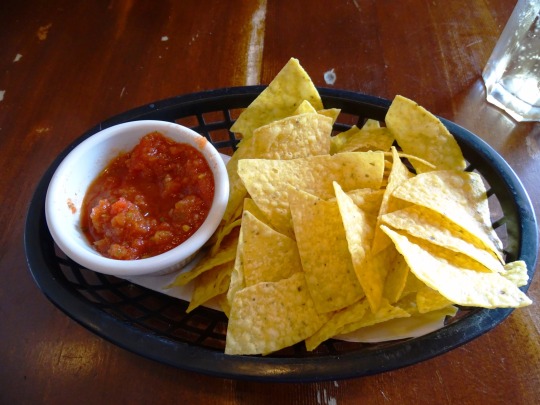




















National Corn Chip Day
National Corn Chip Day is celebrated on January 29 every year. Corn chips are loved by people of different races and ages. It is crispy, crunchy, and made out of cornmeal. The chips are extremely spiced with salt flavor and packed in the bag for longer life. Corn chips can either be eaten alone or with different dips at any time. They’re tasty, they’re yummy, they’re crunchy and they’re called corn chips. National Corn Chip Day would not be complete without savoring that strong taste and flavor of the corn chip.
History of National Corn Chip Day
Corn chips have been available to eat since 1932. Charles Elmer Doolin is the man who popularized corn chips. Doolin owned a candy store, but he needed to increase his stock by including corn chips. Unfortunately, all the fried tortillas he attempted grew stale very fast. But as history goes, one day he tried out fried corn dough strips sold by a local gas station. He loved it, and as soon as he got the recipe, Doolin enriched it and immediately sold bags of it from his shop in 1932. In 1945, Doolin came to an agreement with Herman Lay (of Lay’s potato chips) to distribute Doolin’s Fritos across the country. By the 1950s, Fritos had evolved into a bestseller of corn chips across the United States. The two companies (Frito and Lay) were incorporated in 1959, after Doolin’s death, to be known as Frito-Lay.
Today in the U.S., Fritos is one of the oldest and most recognized corn chips. A corn chip is usually prepared from cornmeal and is fried in oil, or baked. Apparently, corn chips or Fritos are often confused with the tortilla chip as the two of them are produced from cornmeal, which is baked or fried in hot oil. It often has the shape of a small scoop of pasta and a strong aroma and flavor of roasted corn. The chips are seasoned with a lot of salt and are thick, crispy, and very crunchy. They’re healthy and perfect for every season but, like everything else, should be eaten in moderation.
National Corn Chip Day timeline
1930s The Corn Chip Is Born
Corn chips are first made.
1945 Corn Chips Are First Distributed
Doolin comes to an agreement with Herman Lay (of Lay's potato chips) to distribute Doolin’s Fritos across the country.
1950s Fritos Become Popular
Fritos becomes a best-selling corn chip in the U.S.
1959 Fritos and Lays Merge
The two companies (Frito and Lay) form a merger, after Doolin’s death, known as 'Frito-Lay.'
National Corn Chip Day FAQs
Are corn chips and tortilla chips the same?
Corn chips are made out of ground lime-cooked masa that is shaped and deep-fat-fried, while tortilla chips are made from pieces of baked tortillas that are deep-fat-fried.
Are corn chips good for weight loss?
They’re those myths that corn chips are very fattening, but that’s not 100% true. Corn chips can actually be a diet-healthy alternative when eaten in moderation.
What are some dips used to eat corn chips?
These are some of the best-rated dips for corn chips: Salsa, Spicy Vegan Butternut Queso, Creamy Tahini Dip, Pepita Pesto, Roasted Garlic, Salsa Verde, Red Lentil Hummus, Roasted Red Pepper Dip, and Green Pea Guacamole.
How to Celebrate Corn Chip Day
Eat corn chips
Host a corn chip party
Make it at home
Eat corn chips and have fun doing it. With the varieties of corn chips to enjoy from, you can buy a lot and mix them up. That way you get a different but similarly delightful flavor in every chip.
With the idea of mixing up different chips, you can get different dips as well for a little party. Play games, live, laugh, love, and eat crunchy corn chips.
Got a little time on your hands? You can get to learn about corn chips and how to prepare them at your home. Don't forget the dips!
5 Amazing Facts About Corn Chips
Chips and dip straight out of the bag
Fritos were the first corn chips
Frito Chili Pie
Lay popularized Fritos
Fritos had a restaurant in Disneyland
In some regions, pouring the chili into a bag of corn chips and eating the mixture directly from the bag is a norm.
The first corn chip is the Fritos Corn Chip, initially sold in the 1930s.
'Frito Chili Pie' is a type of pie invented in the 1960s by Teresa Hernández, a cook in Santa Fe.
Fritos became huge after joining up with Lay's.
After Disneyland opened in 1955, Casa de Fritos happily opened its doors for visitors to have a taste of Mexican specials like tamales and enchiladas.
Why We Love Corn Chip Day
Corn chips are healthy
We get to eat a lot of chips
It's a day to get together
With just three basic ingredients: corn, salt, and veggie oil, corn chips are lower in fat than regular chips and can be a healthy option when enjoyed in moderation.
Maybe we're on a diet and badly craving chips. Corn Chip Day is an excuse to eat as much as we can, without feeling guilty. Did we mention how low it is in fat?
What shouts “party!” louder than a big bowl of chips? especially assorted chips. They can be sneaked into any type of party, and enjoyed.
Source
#Taco Salad#Bacon Avocado Burger#Jaime-Style with cheese & sauce Burrito#salsa#USA#appetizer#entrée#Artichoke and Spinach Dip#Macho Nachos#Canada#the best green salsa#Taco Temple#original photography#vacation#travel#National Corn Chip Day#NationalCornChipDay#29 January#tex-mex food#fries#Cabbage Salsa
2 notes
·
View notes
Note
Oh, follow up then.
1) Soft shell, or hard shell tacos?
2) What taco fillings?
3) What kind of pasta?
4) What sauce?
5) What protein?
mexican tacos!!! corn tortillas with carnitas, onions, cilantro, lime, and salsa verde 🤤
then a chicken or prosciutto pesto pasta with tagliatelle pasta ✨✨
6 notes
·
View notes
Text
need to start cooking again… wanna make a salad with melon and arugula and prosciutto and summer squash agnolotti in a mushroom brodo maybe try to make a sort of savory cannoli (sacrilege) with nduja sausage maybe and a salsa verde or pesto and some sorta roasted fish with potatoes
4 notes
·
View notes
Text
23 recetas de albahaca fresca para pesto y más allá
Si estás mirando un excedente de hierbas de cosecha propia, o recientemente se convirtió en jamón en el mercado de agricultores, no se preocupe. Nuestras recetas de albahaca favoritas abarcan todo tipo de formas de poner al gigante verde a funcionar para que nunca tenga que lanzar con culpa un grupo marchito. Por mucho que amemos el pesto y Realmente, realmente lo hacemos—No no es la única forma…
0 notes
Text
La pizza con pesto es una versión fresca y sofisticada de la clásica pizza italiana. Aquí, el tradicional tomate se sustituye por una vibrante salsa de pesto hecha en casa, y se combina con una mezcla cremosa de quesos sobre una masa artesanal. El resultado es una pizza aromática, llena de textura, con una corteza dorada y el sabor inconfundible de la albahaca y el ajo. #recipe #recipeoftheday #receta #Rezept #ricetta #vegetarian #food #foodpic #foodporn #foodie #foodstagram #follow #Baked #Baking #yummy #yummyfood #instafood #instagood #pizza
1 note
·
View note
Text
Aquí tienes un recetario saludable y sin carne para una semana, equilibrado en nutrientes, proteínas vegetales, fibra y grasas saludables. Incluye opciones vegetarianas (si consumes lácteos y huevos) y alternativas veganas. Imágenes: Gastronomía / revistadiabetes.org Lunes Desayuno: Avena con frutas y nueces: ½ taza de avena cocida en leche vegetal (almendra, soja). ½ plátano en rodajas, 5 fresas picadas, 1 cucharadita de semillas de chía. 1 cucharada de almendras fileteadas. Media mañana: 1 yogur griego natural (o yogur de soja) con 1 puñado de arándanos. Almuerzo: Ensalada de quinoa y garbanzos: ½ taza de quinoa cocida, ½ taza de garbanzos, espinacas, tomate cherry, pepino y aguacate. Aliño: limón, aceite de oliva y una pizca de sal. Merienda: 1 manzana con 1 cucharada de mantequilla de cacahuete sin azúcar. Cena: Lentejas estofadas con verduras: Lentejas cocidas con zanahoria, apio, cebolla y tomate. Acompañar con puré de boniato y espinacas salteadas con ajo. Martes Desayuno: Smoothie verde: 1 taza de espinacas, ½ aguacate, 1 plátano, 1 taza de leche de soja y 1 cucharada de proteína vegetal (opcional). Media mañana: 1 puñado de nueces (20 g) y 1 mandarina. Almuerzo: Wrap integral con hummus y verduras: Tortilla integral con hummus, zanahoria rallada, lechuga, pimiento asado y germinados. Merienda: Bastones de zanahoria y pepino con guacamole. Cena: Tofu salteado con vegetales: Tofu firme marinado en salsa de soja y jengibre, salteado con brócoli, champiñones y pimiento. Acompañar con arroz integral. Miércoles Desayuno: Tostadas de aguacate y huevo (o tofu revuelto para veganos): Pan integral tostado con aguacate machacado, huevo pochado (o tofu salteado con cúrcuma). Espolvorear semillas de sésamo. Media mañana: 1 taza de kéfir (o bebida de coco fermentada) con ½ taza de granola sin azúcar. Almuerzo: Buddha bowl: Base de arroz integral, edamame, remolacha asada, col lombarda, aguacate y tahini. Merienda: 1 rodaja de piña fresca. Cena: Calabacín relleno de quinoa y champiñones: Mezcla de quinoa cocida, champiñones salteados, cebolla y tomate. Cubrir con queso vegano (opcional). Jueves Desayuno: Batido de frutos rojos y avena: ½ taza de frutos rojos congelados, ½ taza de avena, 1 taza de leche vegetal y 1 dátil sin hueso. Media mañana: 1 huevo duro (o 1 puñado de garbanzos tostados). Almuerzo: Sopa de miso con verduras y tofu: Caldo de miso, wakame, tofu suave, zanahoria y cebollino. Acompañar con 2 onigiri (bolas de arroz integral con semillas de sésamo). Merienda: 2 cuadritos de chocolate negro (70% cacao) con 5 almendras. Cena: Espaguetis de calabacín con pesto de albahaca y nueces: Pesto casero (albahaca, ajo, nueces, aceite de oliva). Añadir tomates secos. Viernes Desayuno: Chía pudding: 3 cucharadas de semillas de chía en leche de coco, dejadas en la nevera toda la noche. Cubrir con mango y coco rallado. Media mañana: 1 pera y 1 puñado de avellanas. Almuerzo: Ensalada de lentejas y aguacate: Lentejas, rúcula, aguacate, nueces y vinagreta de mostaza. Merienda: 1 taza de palomitas de maíz caseras (sin mantequilla). Cena: Curry de garbanzos y espinacas: Cebolla, ajo, jengibre, leche de coco light, garbanzos y espinacas. Servir con cuscús integral. Sábado Desayuno: Tortitas de avena y plátano: Mezclar 1 plátano, 2 huevos (o 2 cucharadas de harina de garbanzo + agua para veganos) y avena. Cocinar en sartén antiadherente. Media mañana: 1 vaso de jugo verde (apio, pepino, manzana y jengibre). Almuerzo: Tacos de jackfruit (o setas): Jackfruit desmenuzada cocinada con especias tipo “barbacoa”, en tortillas de maíz. Acompañar con pico de gallo y frijoles negros. Merienda: 1 rodaja de sandía. Cena: Risotto de champiñones y espárragos (usar vino blanco y caldo vegetal, queso parmesano vegano opcional). Domingo Desayuno: Tostadas con tomate y aceite de oliva: Pan integral con tomate triturado, aceite de oliva virgen y orégano. 1 huevo escalfado (opcional). ...

View On WordPress
0 notes
Text
The allure of pasta: a culinary journey.
Pasta is more than simply a basic cuisine; it is a cherished dish that has permeated civilizations all over the world. Pasta, from its humble origins in ancient civilizations to its current role as a comfort dish in modern households, is a rich tapestry of history, variation, and flavor. Join me on a gourmet trip into the intriguing world of pasta. A Brief History of Pasta Pasta originated in prehistoric times. While numerous cultures have contributed to its growth, it is usually assumed that the Chinese were among the first to develop noodle-like meals, approximately 2000 BC. But it wasn't until the eighth century that spaghetti began to take the form of something that is recognized by us today, especially in italy. Pasta became popular on the Italian peninsula, and many regional variations emerged as a result. Pasta evolved into a flexible canvas for flavors and ingredients, from the thick, packed ravioli to the thin, delicate strands of spaghetti.

Pasta Types Pasta is available in a variety of sizes and forms, each having a special use and pairing: 1. **Long Pasta**: Lighter sauces like olive oil, garlic, and fresh herbs go well with spaghetti, linguine, and fettuccine. 2. **Short Pasta**: Penne, fusilli, and macaroni retain the texture and tastes of the sauce, making them perfect for baked meals or thick sauces. 3. **Stuffed Pasta**: Tortellini and ravioli are frequently stuffed with cheese, meat, or vegetables, making them filling dishes that need a sauce to balance their richness. 4. **Specialty Pasta**: Gluten-free, whole wheat, and legume-based pasta options cater to diverse dietary needs without sacrificing flavor. ## Perfect Pasta Preparation Pasta cooking is an art form that demands precision. The following advice will help you make pasta that is flawless: - **Use Plenty of Water**: Pasta cooks more evenly and is less sticky when cooked in a big pot of boiling salted water. **Al Dente is Key**: For optimal texture, strive for a firm bite (al dente). This improves the pasta's ability to absorb sauces and adds flavor. Avoid rinsing pasta unless you're using it in a cold dish, such as spaghetti salad, as this removes the starch that helps sauces stick to it. ## Sauces: The Key Ingredient in Pasta Recipes Creativity comes through in the sauce. Here are some traditional choices: **Marinara**: An easy tomato sauce that goes well with any type of pasta and contains herbs and garlic. A common accompaniment to fettuccine is alfredo, a creamy mixture of butter, cream, and Parmesan cheese. **Pesto**: A savory and quick dish, this fresh and lively sauce is created with garlic, pine nuts, basil, and olive oil. The greatest way to enjoy a rich meat sauce that has been perfectly simmered is with tagliatelle or pappardelle.
Pasta in Different Countries Even while pasta is commonly associated with Italian food, it has been borrowed and modified by many other cultures: Asian noodles, such as Thai rice noodles and Japanese udon, demonstrate the diversity of pasta-like ingredients. A typical American comfort food, macaroni and cheese is a filling dish that appeals to people of all ages. It consists of noodles and a creamy cheese sauce. - **Latin American pasta**: Peruvian "tallarines verdes" and other dishes that use pasta in distinctive, tasty sauces. Conclusion Pasta is a food that unites people at the dinner table and cuts across boundaries. Every mouthful of food, whether it's a rich ravioli or a basic spaghetti with sauce, tells a tale. Now take a fork and spin some pasta and discover the endless possibilities that pasta has to offer!
0 notes
Text
Lunchtime in Union, NJ? Enjoy a Quick & Flavorful Peruvian Feast at El Gordo

If you’re looking for a delicious and satisfying lunch in Union, NJ, El Gordo Peruvian Eatery is your go-to destination. Whether you’re on a quick break from work or craving an authentic taste of Peru, our lunch specials offer a perfect blend of flavor, convenience, and affordability.
At El Gordo Eatery, we take pride in serving traditional Peruvian dishes, each crafted with authentic ingredients and bold flavors. From savory Lomo Saltado to our famous Pollo a la Brasa, every meal is designed to transport your taste buds to the heart of Peru—right here in Union!
Quick, Delicious, and Affordable – The Perfect Lunch Spot
When lunchtime hits, you want a meal that’s quick, delicious, and satisfying. At El Gordo Eatery in Union, we offer:
Fast Service for Busy Schedules: We understand that lunch breaks are short, so we ensure prompt service without compromising on quality.
Authentic Peruvian Flavors: Experience the bold and diverse tastes of Peru’s culinary heritage in every dish.
Affordable Lunch Specials: Enjoy gourmet Peruvian meals without breaking the bank.
Convenient Pickup & Delivery: Whether you’re dining in, grabbing takeout, or ordering for the office, we make it easy to enjoy a flavorful lunch on the go.
Explore Our Popular Peruvian Lunch Specials
1. Lomo Saltado – A Must-Try Classic
A customer favorite, Lomo Saltado is a mouthwatering stir-fry of tender beef, onions, and tomatoes, sautéed with soy sauce and served with crispy French fries and rice. This dish is savory, satisfying, and packed with bold flavors.
2. Pollo a la Brasa – The Ultimate Rotisserie Chicken
Our signature Peruvian-style rotisserie chicken is marinated in a blend of spices and slow-roasted to perfection. Enjoy it with your choice of rice, fries, or a fresh salad.
3. Aji de Gallina – A Creamy Peruvian Delight
Shredded chicken cooked in a rich, creamy sauce made from Peruvian yellow peppers, cheese, and spices. Served with rice and potatoes, this dish is a perfect balance of heat and comfort.
4. Tallarines Verdes – Peruvian Pesto Pasta
For a vegetarian-friendly option, try our Tallarines Verdes, a Peruvian twist on pesto pasta, made with a flavorful blend of basil, spinach, and queso fresco.
5. Arroz Chaufa – Peruvian-Style Fried Rice
Inspired by Peru’s fusion of Asian and Latin flavors, Arroz Chaufa is a hearty fried rice dish mixed with chicken, beef, or seafood, seasoned with Peruvian spices.
6. Ceviche – A Fresh & Zesty Option
Need a light yet flavorful lunch? Our Peruvian ceviche features fresh fish marinated in lime juice, Peruvian spices, and red onions, served with sweet potato and corn for a refreshing midday meal.
Pair Your Meal with Traditional Peruvian Beverages
No Peruvian meal is complete without authentic drinks to complement the bold flavors. Choose from:
Chicha Morada – A refreshing, purple corn-based drink infused with cinnamon and cloves.
Inca Kola – Peru’s famous golden soda, with a sweet, bubblegum-like taste.
Maracuya (Passion Fruit Juice) – A tangy and tropical delight, perfect for a hot day.
Dine In, Take Out, or Order Online for Delivery
At El Gordo Eatery in Union, we make lunchtime easy and accessible. Whether you’re dining in, grabbing a quick takeout order, or having your meal delivered, we ensure you get a fast, flavorful, and satisfying experience.
Find Us in Union, NJ El Gordo Peruvian Eatery is conveniently located in Union, NJ, serving up authentic Peruvian lunch specials every day. We also have locations in Jersey City and Passaic for more dining options.
Make Your Lunch Break a Flavorful Experience!
Don’t settle for an ordinary lunch—treat yourself to a flavorful Peruvian feast at El Gordo Eatery in Union, NJ. Whether you’re in the mood for savory stir-fries, juicy rotisserie chicken, or fresh ceviche, we have something to satisfy your cravings.
Short on time? Order ahead for pickup or delivery and enjoy a delicious Peruvian meal wherever you are.
Visit El Gordo Eatery today and discover why we’re Union’s top spot for a quick and flavorful Peruvian lunch!
1 note
·
View note
Text
Preguntan a 3 chefs sobre la mejor forma de cocinar el brócoli: todos responden lo mismo
Historia de Redacción LOS40, 10/01/2025

Cada chef tiene sus propios secretos y técnicas para resaltar los sabores de los ingredientes. Sin embargo, cuando se trata de cocinar brócoli, tres chefs de renombre a los que ha preguntado un periodista del medio Simply Recipes coinciden en un punto esencial: el blanqueo es el paso clave para obtener los mejores resultados. Este consenso abrumador destaca la importancia de este proceso para garantizar que el brócoli mantenga su sabor, textura y color vibrante.
Blanquear el brócoli es un proceso sencillo pero crucial. Consiste en sumergir los floretes en agua hirviendo durante un corto período de tiempo y luego enfriarlos rápidamente en un baño de hielo. Este método ayuda a preservar el color verde brillante del brócoli y a mantener su textura crujiente. Según Nathan Molina, chef de Genesee Valley Store, "los floretes se blanquean rápidamente en agua hirviendo tan salada como el mar durante aproximadamente 1 minuto. Luego se retiran de inmediato y se sumergen en un baño de hielo para detener el proceso de cocción".
Preparación previa
Antes de blanquear el brócoli, es importante prepararlo adecuadamente. Esto implica cortar las hojas, los tallos y las coronas. Molina sugiere que el brócoli puede incluso blanquearse un día antes y luego almacenarse en el frigorífico en un recipiente hermético para recalentarlo cuando sea necesario. Para aquellos que prefieren preparar las comidas con anticipación, también es posible hacer una tanda más grande y almacenar los floretes en el congelador durante semanas.
Versatilidad post-blanqueo
Una vez blanqueado, el brócoli se convierte en un ingrediente extremadamente versátil. El chef Jamie Simpson, chef ejecutivo de The Culinary Vegetable Institute, destaca varias formas de preparar el brócoli después del blanqueo. "Para una receta específica, asamos el brócoli sobre un fuego de leña, lo cocinamos al vapor para obtener un puré con mostaza y lo cortamos en láminas para obtener una ensalada crujiente y con limón". Simpson enfatiza que "cocinar es opcional", ya que el brócoli puede ser disfrutado de múltiples maneras.
Método de asado
El asado es una de las formas más populares de preparar el brócoli después del blanqueo. Después de blanquear el brócoli, se pueden cortar los floretes por la mitad, rociarlos con aceite de oliva y espolvorearlos con sal kosher y pimienta negra molida. Luego, se colocan los floretes en una bandeja para hornear y se hornean durante unos 10 minutos a 200 °C. Para un toque adicional de sabor, se pueden agregar trozos desmenuzados de queso cheddar añejo fuerte o virutas de parmesano fresco antes de hornear durante uno o dos minutos más hasta que el queso se derrita. Antes de servir, se puede rociar un poco de jugo de limón por encima y condimentar con más sal y pimienta.
Aprovechando todas las partes del brócoli
El chef privado y ex sous chef de Zou Zou, Jimmy Vasquez, advierte: "¡NO TIRES LOS TALLOS!". Los tallos de brócoli tienen sabores dulces y terrosos y son la parte más beneficiosa para la salud de toda la planta. Los tallos se pueden utilizar en varios platos, como sopas y guisos, ensaladas, pesto, hummus y mucho más. Aunque las hojas de brócoli pueden tener un sabor amargo, también se pueden guardar y "saltear con un poco de aceite y cortar con un poco de ajo picado y limón" para realzar el sabor
El consenso entre estos tres chefs es claro: blanquear el brócoli es un paso esencial para obtener los mejores resultados. Este proceso no solo preserva el color y la textura del brócoli, sino que también lo convierte en un ingrediente versátil que puede ser preparado de diversas maneras. Desde el asado hasta el vapor, pasando por el uso de los tallos y las hojas, el brócoli blanqueado ofrece una amplia gama de posibilidades culinarias. Así que la próxima vez que cocines brócoli, no olvides blanquearlo primero para disfrutar de su sabor y textura en su máxima expresión.
Fuente: LOS40
0 notes
Text

16 Ervas Que Podem Crescer Na Água e Prosperar o Ano Todo 🌿💧
- Cultivar um jardim de ervas em casa é fácil e prático, especialmente quando se opta por crescer ervas na água.
- Ervas como manjericão, tomilho, hortelã e salsa não apenas aprimoram o sabor dos pratos, mas também se desenvolvem facilmente em água, sem bagunça e sem pragas.
- Aqui estão 16 ervas que podem ser cultivadas na água:
1. Manjericão: Coloque estacas frescas em água e, em algumas semanas, raízes se formarão. O manjericão é rico em antioxidantes e pode ser usado em saladas, molhos e pestos.
2. Catnip: Além de atrair gatos, suas estacas também crescem bem na água. Pode ser usado em chás e infusões, proporcionando relaxamento.
3. Coentro: Coloque estacas em água e, quando as raízes aparecerem, transfira para o solo. O coentro é rico em vitaminas e dá um toque especial a salsas e curries.
4. Funcho: Corte um talo e coloque na água, mantendo a parte bulbosa submersa. O funcho é ótimo para digestão e pode ser usado em saladas e sopas.
5. Gengibre: Submerja um rizoma em água e aguarde o crescimento das raízes. O gengibre é excelente em chás e pratos, com propriedades anti-inflamatórias.
6. Lavanda: Coloque estacas em água para raízes se formarem. A lavanda é conhecida por suas propriedades calmantes e pode ser usada em chás e sobremesas.
7. Erva-cidreira: Coloque estacas em água em um local ensolarado. A erva-cidreira é refrescante e pode ser usada em chás e saladas.
8. Capim-limão: Corte estacas de 15 a 20 cm e coloque na água. O capim-limão é ótimo para sopas e marinadas, com propriedades antimicrobianas.
9. Manjerona: Coloque estacas de 7 a 8 cm em água. A manjerona é doce e pode ser usada em molhos e pratos grelhados.
10. Orégano: Coloque estacas de 10 a 15 cm em água e troque a água a cada 3-4 dias. O orégano é conhecido por suas propriedades antimicrobianas.
11. Hortelã: Coloque estacas em água e mantenha em local ensolarado. A hortelã é refrescante e ótima para bebidas e sobremesas.
12. Alecrim: Coloque estacas verdes em água e aguarde raízes. O alecrim é perfeito para temperar carnes e pães.
13. Sálvia: Coloque estacas de 15 a 20 cm em água, mantendo as folhas acima da superfície. A sálvia tem um sabor robusto e é amplamente utilizada na culinária.
14. Stevia: Corte um galho saudável e coloque em água. A stevia é um adoçante natural e pode ser usada em bebidas e sobremesas.
15. Estragão: Coloque estacas em água e transfira para o solo quando as raízes aparecerem. O estragão é excelente em vinagres e pratos de frutos do mar.
16. Tomilho: Coloque estacas em água em um local ensolarado. O tomilho é versátil e pode ser usado em sopas e pratos assados.
- Cultivar ervas na água proporciona um suprimento constante de folhas aromáticas para cozinhar e fazer chás, permitindo desfrutar de ervas frescas durante todo o ano. Experimente hoje mesmo! 🌱
https://shopee.com.br/search?keyword=jardim
0 notes
Text
Top 5 Creative Uses for a Parsley Chopper in Your Kitchen
A parsley chopper might seem like a niche kitchen gadget, but it’s a game-changer for anyone who loves cooking. Designed to finely chop parsley with ease, this tool isn’t limited to herbs. Its versatility and efficiency make it an indispensable addition to any home cook’s arsenal. Let’s dive into the top five creative uses for a parsley chopper that will elevate your culinary game.
Perfectly Chopped Herbs for Garnishes
The primary purpose of a parsley chopper is, of course, chopping parsley and other herbs. From parsley to coriander, basil to mint, this tool ensures consistent, finely chopped herbs in seconds. Instead of struggling with a knife and cutting board, a parsley chopper delivers precision without the hassle.
Why is this important? Garnishes are more than decorative; they enhance the flavour and aroma of dishes. Whether you’re sprinkling fresh parsley over pasta or adding a touch of mint to a dessert, finely chopped herbs provide a professional touch that transforms ordinary meals into extraordinary creations. With a parsley chopper, you’ll achieve that restaurant-quality garnish effortlessly.
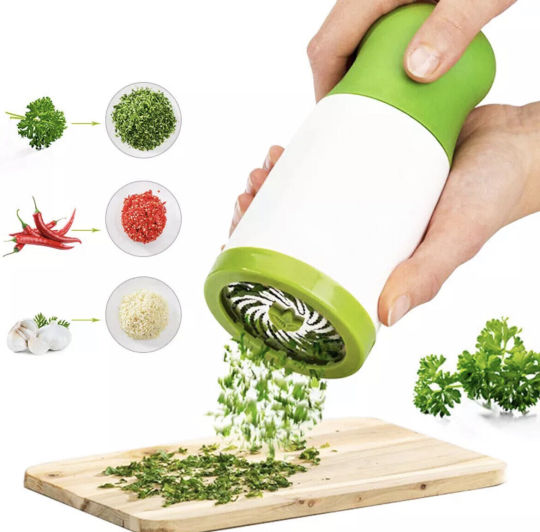
Homemade Herb Mixes and Seasonings
If you’ve ever purchased pre-packaged herb mixes, you know they’re often expensive and lack the freshness of homemade alternatives. A parsley chopper allows you to create your own herb blends at home, tailored to your taste preferences.
For instance, you can combine parsley, oregano, thyme, and rosemary to make a Mediterranean mix perfect for roasting vegetables or seasoning meats. Alternatively, chop cilantro, green onions, and chili for a zesty taco topping. By using a parsley chopper, the herbs are uniformly chopped, ensuring the flavours blend harmoniously. You can also store your herb mixes in airtight containers or freeze them in small portions for later use, maximising freshness and convenience.
Effortless Preparation of Aromatic Bases
Many cuisines rely on aromatic bases—a combination of finely chopped vegetables and herbs—to create flavourful dishes. Think of Italian soffritto, French mirepoix, or Cajun holy trinity. A parsley chopper can simplify this prep work, saving you time and effort.
For example, you can use the chopper to mince parsley, garlic, and onions together for a quick and fragrant pasta sauce base. Or, chop parsley alongside celery and carrots for a hearty soup starter. This tool not only speeds up the process but also ensures uniformity, which helps the ingredients cook evenly and release their flavours more effectively.
Making Homemade Sauces and Dressings
Fresh sauces and dressings can transform any dish, and a parsley chopper makes their preparation a breeze. From pesto to chimichurri, tzatziki to salsa verde, this tool ensures that herbs and other ingredients are finely chopped to the perfect consistency.
For a classic chimichurri, chop parsley, garlic, and oregano, then mix with olive oil, red wine vinegar, and chili flakes. Use it as a marinade, condiment, or dip. Similarly, you can create a quick salsa verde by combining parsley, capers, anchovies, and lemon juice. These fresh, vibrant sauces enhance everything from grilled meats to roasted vegetables.
Additionally, parsley choppers are great for making salad dressings. A finely chopped mix of parsley, dill, and chives, combined with olive oil, lemon juice, and mustard, creates a fresh and tangy dressing that’s perfect for leafy greens or potato salads.
Chopping Nuts, Chocolate, and More
A parsley chopper’s functionality extends beyond herbs. Its design makes it perfect for chopping other ingredients that are challenging to handle with a knife. For instance, you can use it to chop nuts like almonds, walnuts, or pistachios for baking or as a topping for desserts and salads.
Similarly, it’s excellent for chopping chocolate into fine pieces for melting or as a garnish. Imagine using chopped dark chocolate on a bowl of ice cream or a slice of cheesecake. The even consistency achieved by the parsley chopper ensures that every bite is perfectly balanced.
Other creative uses include chopping dried fruits, such as dates or apricots, for energy bars and baking. You can also use it to break down hard cheeses like Parmesan for a salad topping or pasta dish. The possibilities are endless, making this tool far more versatile than its name suggests.
Tips for Using a Parsley Chopper Effectively
To get the most out of your parsley chopper, here are a few tips:
Don’t overload: Chop ingredients in small batches to ensure even consistency.
Use fresh ingredients: Fresher herbs and produce will yield better results and prevent clogging.
Clean promptly: Wash the chopper immediately after use to avoid dried residue that’s hard to remove.
Experiment: Don’t hesitate to try chopping unconventional ingredients like ginger, small vegetables, or even breadcrumbs.
Why Invest in a Parsley Chopper?
While many kitchen gadgets promise convenience, a parsley chopper delivers both functionality and versatility. It saves time, ensures precision, and reduces the mess associated with traditional chopping methods. Whether you’re a seasoned cook or a beginner, this tool can simplify meal prep and inspire creativity in the kitchen.
Moreover, its compact design makes it easy to store, and it’s often more affordable than larger food processors. If you’re looking to streamline your cooking while maintaining a high standard of quality, a parsley chopper is a worthwhile investment.
Final Thoughts
The parsley chopper is far more versatile than its name suggests. From finely chopped herbs for garnishes to preparing aromatic bases, creating homemade sauces, and even chopping nuts or chocolate, this handy tool has a place in every kitchen. By exploring its full potential, you’ll not only save time but also elevate the flavour and presentation of your dishes. If you don’t already own a parsley chopper, now might be the perfect time to add this multi-functional gadget to your kitchen repertoire.
0 notes